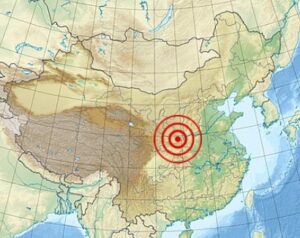 Apparently, earthquake documentation began about 4,000 years ago. That is a fact about which I had no idea. I’m sure the early documentation was somewhat primitive, because they would simply have to be recorded in journal of sorts. Many don’t realize that the process of measuring began nearly 2000 years ago, with the invention of the first actual seismoscope in 132 AD by a Chinese inventor called Zhang (‘Chang’) Heng. The device was remarkably accurate in detecting earthquakes from afar, and did not rely on shaking or movement in the location where the device was situated. Of some of the earliest recorded earthquakes, the deadliest occurred in China on January 23, 1556. While this quake was not the largest ever recorded, it was a powerful quake that rocked the province of Shaanxi and the neighboring province of Shanxi. The reason it was such a deadly quake was not the size, but rather the death toll, which was an estimated 830,000 people.
Apparently, earthquake documentation began about 4,000 years ago. That is a fact about which I had no idea. I’m sure the early documentation was somewhat primitive, because they would simply have to be recorded in journal of sorts. Many don’t realize that the process of measuring began nearly 2000 years ago, with the invention of the first actual seismoscope in 132 AD by a Chinese inventor called Zhang (‘Chang’) Heng. The device was remarkably accurate in detecting earthquakes from afar, and did not rely on shaking or movement in the location where the device was situated. Of some of the earliest recorded earthquakes, the deadliest occurred in China on January 23, 1556. While this quake was not the largest ever recorded, it was a powerful quake that rocked the province of Shaanxi and the neighboring province of Shanxi. The reason it was such a deadly quake was not the size, but rather the death toll, which was an estimated 830,000 people.
The 1556 Shaanxi quake was historically referred to as the Jiajing Great Earthquake because it occurred during Emperor Jiajing’s reign in the Ming dynasty. While death tolls might not be as accurate as they are today, the approximate death toll comes from local annals that also tracked 26 earthquakes in the region. Those records described the earthquake as being “starkly different” from others, saying that it leveled mountains, caused floods and fires that burned for days, and a drastically altered landscape. The annals estimated that some counties lost about 60% of their population.
Due to the inability to have accurate fatality recordings, the death toll is in question, but no one questions the  fact that the Shaanxi earthquake is considered the deadliest earthquake, because it is certain that the casualties are much higher than any other disaster. Following the Shaanxi quake, the second deadliest recorded earthquake was the 2004 earthquake and tsunami in the Indian Ocean that killed an estimated 230,000 people across Indonesia, Thailand, Sri Lanka and India. It is amazing to me that the next deadliest quake took so long to occur, considering the fact that making earthquake resistant structures didn’t begin immediately. Still, it is a blessing that many earthquakes don’t bring those huge death tolls.
fact that the Shaanxi earthquake is considered the deadliest earthquake, because it is certain that the casualties are much higher than any other disaster. Following the Shaanxi quake, the second deadliest recorded earthquake was the 2004 earthquake and tsunami in the Indian Ocean that killed an estimated 230,000 people across Indonesia, Thailand, Sri Lanka and India. It is amazing to me that the next deadliest quake took so long to occur, considering the fact that making earthquake resistant structures didn’t begin immediately. Still, it is a blessing that many earthquakes don’t bring those huge death tolls.
In the 1930s, the Richter scale was developed, and the magnitude of quakes became much clearer. Scientists theorized that the Shaanxi earthquake was likely between 8.0 to 8.3 in magnitude…definitely not the strongest ever recorded, but no less destructive. The most powerful earthquake recorded on the Richter scale was the 9.5-magnitude Valdivia Earthquake that struck Chile in 1960, according to the US Geological Survey (USGS). The seismic event created a tsunami which together killed an estimated 5,700 people…a far lesser number than the Shaanxi quake…amazingly. The 2004 Indian Ocean tsunami registered a 9.3 magnitude. So, the size of the quake cannot totally correlate to the death toll. The death toll is based more on the population in the area and the quality of the structures.
As to the Shaanxi quake, while it wasn’t the strongest recorded earthquake, its high death toll likely resulted from the destruction of the area’s densely populated communities and poorly constructed stone buildings. The people of the Shaanxi and Shanxi provinces responded to the disastrous quake by rebuilding in ways that would  lessen the impact of future earthquakes, according to local records. Rather than us stone to rebuild, they used softer materials like bamboo and wood, which were more resistant to tremors and would cause less damage if knocked down again. They knew that they couldn’t prevent earthquakes, but they could make their impact less severe.
lessen the impact of future earthquakes, according to local records. Rather than us stone to rebuild, they used softer materials like bamboo and wood, which were more resistant to tremors and would cause less damage if knocked down again. They knew that they couldn’t prevent earthquakes, but they could make their impact less severe.
“At the very beginning of the earthquake, people indoors should not go out immediately. Just crouch down and wait for chances. Even if the nest is collapsed, some eggs in it may still be kept intact,” said earthquake survivor and scholar, Qin Keda, who wrote about his experience and came up with safety tips for people to follow in the event of another disaster.


Leave a Reply